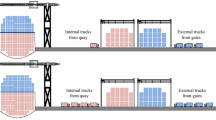Abstract
As a consequence of continuing growth of container volume and the introduction of 12 000 TEU plus containerships into major trade routes, the port industry is under pressure to come up with the necessary capacity to accommodate the increasing freight volume. One critical issue is the marine terminal gate capacity. Limited gate capacity leads to congestion. The harbor trucking industry operates in a very competitive environment; gate congestion is detrimental to their economic well-being. This article applies a multi-server queuing model to analyze marine terminal gate congestion and quantify truck waiting cost. An optimization model is developed to balance the gate operating cost and trucker’s cost associated with excessive waiting time. The model is tested using data from field observations. A case study is applied to analyze gate congestion behavior and truck waiting cost. Model sensitivity is discussed. The results indicate that truck waiting cost at marine terminal gates is an issue that needs to be addressed. A truck appointment system seems to be the most viable way to reduce gate congestion and increase system efficiency. With an optimized appointment system, the total system costs, especially truck waiting cost, can be drastically reduced.





Similar content being viewed by others
References
Ballis, A. and Abacoumkin, C. (1996) A container terminal simulation model with animation capabilities. Journal of Advanced Transportation 30 (1): 37–57.
Cosmetatos, G. (1976) Some approximation equilibrium: Results for the multi-server queue (M/G/r). Operational Research Quarterly 27 (3, Part 1): 615–629.
Dragovic, B., Park, N.K. and Radmilovic, Z. (2006) Ship-berth link performance evaluation: Simulation and analytical approaches. Maritime Policy and Management 33 (3): 281–299.
Giuliano, G., Hayden, S., Dell’aquila, P. and O’Brien, T. (2008) Evaluation of the Terminal Gate Appointment System at the Los Angeles/Long Beach Ports. METRANS Transportation Center, California Department of Transportation and University of Southern California. Research Report.
Huynh, N. and Walton, M. (2008) Robust scheduling of truck arrivals at marine container terminals. ASCE Journal of Transportation Engineering 134 (8): 347–353.
Kim, K.H., Lee, K.M. and Hwang, H. (2003) Sequencing delivery and receiving operations for yard crane in port container terminals. International Journal of Production Economics 84: 283–292.
Kozan, E. (1997a) Comparison of analytical and simulation planning models of seaport container terminals. Transportation Planning and Technology 20: 235–248.
Kozan, E. (1997b) Increasing the operational efficiency of container terminals in Australia. The Journal of Operational Research Society 48 (2): 151–161.
Kozan, E. (2000) Optimizing container transfers at multimodal terminals. Mathematical and Computer Modelling 31: 235–243.
Law, A. (2006) Simulation Modeling & Analysis, 4th edn. McGraw Hill, pp. 340–346.
Law, A. and Kelton, D. (2000) Simulation Modeling and Analysis, 3rd edn. New York: McGraw-Hill, pp. 227–228.
Lee, A.M. and Longton, P.A. (1959) Queuing processes associated with airline passenger check-in. Operational Research Quarterly 10 (1): 56–71.
Noritake, M. and Kimura, S. (1983) Optimum number and capacity of seaport berths. ASCE Journal of Waterway, Port, Coastal and Ocean Engineering 109: 323–339.
Noritake, (1985) Congestion cost and pricing of seaports. ASCE Journal of Port, Coastal and Ocean Engineering 111 (2): 354–370.
Rizzoli, A., Fornara, N. and Gambardella, L. (2002) A simulation tool for combined rail/road transport in intermodal terminals. Mathematics and Computer Simulation 59 (1–3): 57–71.
Taniguchi, E., Noritake, M., Yamada, T. and Izumitani, T. (1999) Optimal size and location planning of public logistics terminals. Transportation Research Part E 35: 207–222.
Watanabe, Y. (2003) Environmental impact of intermodal transportation by trucks on ports. Proceedings of International Association and Maritime Economics (IAME) and Korean Maritime Institute & Korean Association of Shipping and Logistics; 26–30 June, Busan, pp. 864–873.
Winston, W.L. (1993) Operations Research: Applications and Algorithms, 3rd edn. Belmont, CA: International Thomson Publishing, Duxbury Press, pp. 1109–1111.
Yamade, T., Yoshizawa, G., Frazila, R. and Mori, K. (2003) Optimizing the handling capacity in a container terminal for investigating efficient handling systems. Journal of the Eastern Asia Society for Transportation Studies 5: 597–608.
Author information
Authors and Affiliations
Corresponding author
Rights and permissions
About this article
Cite this article
Guan, C., Liu, R. Container terminal gate appointment system optimization. Marit Econ Logist 11, 378–398 (2009). https://doi.org/10.1057/mel.2009.13
Published:
Issue Date:
DOI: https://doi.org/10.1057/mel.2009.13




